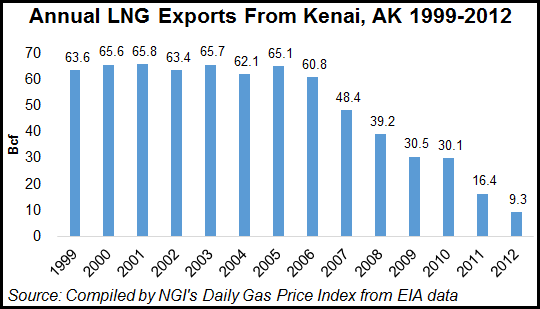LNG | NGI All News Access | NGI The Weekly Gas Market Report
ConocoPhillips Seeks to Resume Alaska LNG Exports
ConocoPhillips Alaska (COPA) has submitted an application to the U.S. Department of Energy (DOE) to resume exports of liquefied natural gas (LNG) from its Kenai, AK, facility located in the Cook Inlet, according to an e-mail to the Alaska Oil and Gas Association (AOGA) and other stakeholders.

The move is in keeping with recent increased interest in developing additional gas supplies in the Cook Inlet and a prompting to ConocoPhillips from state energy officials (see Daily GPI, Sept. 18). COPA said it expects export volumes of up to 20 Bcf/year.
“The state’s objective is to foster an environment in Cook Inlet that continues to provide supplies of gas that are adequate to meet demand and can be reliably contracted for by local utilities. This requires market opportunities in the near term that incentivize companies to invest in the exploration and development today that will lead to secure supplies in the future,” Joseph Balash, acting commissioner of the Alaska Department of Natural Resources, told ConocoPhillips Alaska President Trond-Erik Johansen in a Sept. 5 letter.
The e-mail announcement last week cited the Balash letter as asking for ConocoPhillips’ help in providing a market for increased Cook Inlet gas supplies. Thus, the e-mail noted that COPA has said it would pursue a new export license “if local gas needs were met and there was sufficient supply to support exports.
“The local utilities now have contracts in place that meet their needs through the end of 2017,” ConocoPhillips Alaska’s Portia C. K. Babcock, director of governmental and community affairs, said in the e-mail. “Over the last year, gas production in Cook Inlet has been shut in because there is no market for the gas. Shutting in gas has the potential to reduce deliverability and reserves.”
Babcock added that it is expected the industrial gas market reached via exports “will help keep natural gas fields producing and provide a potential economic basis for exploration/development of new supplies. The market opportunity provided by LNG exports will likely increase energy security for South-Central Alaska. COPA anticipates export volumes of up to 20 Bcf per year.”
COPA reiterated that it is committed to meeting local gas supply contracts and “putting local gas needs first,” and that it would divert its equity and third-party supplies from the LNG export terminal to local buyers during times of peak demand.
COPA’s plans for 20 Bcf/year send out from Kenai is well below the 60 Bcf/year volumes the facility shipped out regularly between 1999-2006.
© 2024 Natural Gas Intelligence. All rights reserved.
ISSN © 1532-1231 | ISSN © 2577-9877 | ISSN © 1532-1266 |
